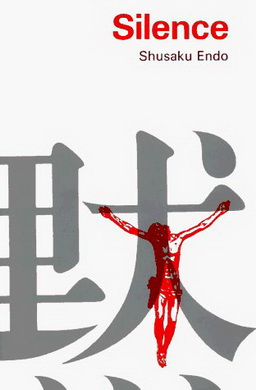Shūsaku Endō, trans. William Johnston (New York: Taplinger, 1969)

Summary:
In early seventeenth-century Japan, when Christians were ruthlessly persecuted and even crucified, some chose to apostatize by stepping on a fumie, an icon bearing Jesus’s image. Seeing one of these scuffed icons in a museum led author Shūsaku Endō to ask himself if he would have become an apostate or a martyr in similar circumstances. From this question came the novel Silence, a work of historical fiction set in Japan. Shūsaku Endō was a Japanese Roman Catholic who published over two dozen novels before dying in 1996. Silence received the Tanizaki Prize, Japan’s equivalent of the Pulitzer.
In the novel, Jesuit priest Sebastian Rodrigues travels to Japan to find his mentor, Father Christovao Ferreira, who supposedly has abandoned the faith. Japan in 1639 was a place where Christians refusing to apostatize were hung upside down and bled to death. Both Rodrigues and Ferreira are based on actual Portuguese missionaries. Silence is written with a concise combination of journal entries, letters, and third-person narration that allows readers to follow Rodrigues on his journey from triumphalism to the edge of martyrdom.
Themes, Symbols, & Motifs:
- Silence. The primary theme of the novel—and one of the most frequently words—is silence, the silence of God and what this silence means for those suffering.
- Suffering. People are tortured and murdered because Rodrigues won’t apostatize. Suffering, rather, should lead to compassion.
- Jesus’s Face. “I don’t know why, but at that moment I thought of the face of yet another man. This was the face of a crucified man, a face for which so many centuries had given inspiration to artists.” Rodrigues’s conception of the face of Jesus transitions from one of perfection and beauty to one of anguish.
- Martyrdom. The deaths of the Christians around Rodrigues are far different than he expected, much less glorious and far crueler.
- Translation. “Trample! It was to be trampled on by men that I was born into this world. It was to share men’s pain that I carried my cross.” The actual Japanese word for trample is more permissive, more accurately translated as “you may trample.”
Discussion Questions:
- How is Rodrigues a Christ figure? Consider his ride on a donkey, persecution, and betrayal for silver.
- When and why does the story’s narration shift from first to third person?
- How do the priests interact with Japanese culture? Consider applying the terms assimilation, separation, or engagement.
- By stepping on the fumie, was Rodrigues participating in the suffering of Christ, a redemptive suffering? Is he even an apostate?
- What is the significance of what we learn in the Appendix, that Rodrigues is known as Apostate Paul and Ferreira as Apostate Peter?
- Apply Martin Luther’s dichotomy of a “theology of glory” vs. a “theology of the cross” to this novel.
- Discuss the arc of the character Kichijiro.
- Apostasy helped Rodrigues become a better follower of Christ. Would you agree?
Drew Trotter